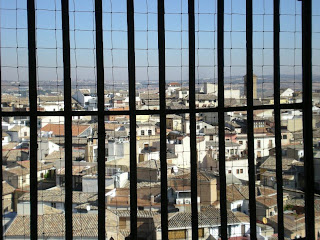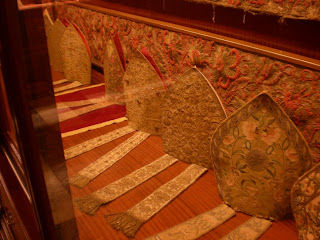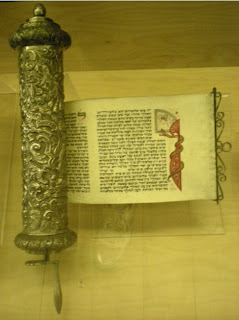Since I was told not to come in until Monday to start school
Ben and I decided to take our first day trip out of Madrid. We headed south to
Toledo, the old capital of Spain. Toledo is surrounded on three sides by a
river which prevented room for expansion so the capital was moved to Madrid
where there was more room to expand out.
We took the train from Madrid to Toledo. It was our first time taking the train here and I was a little anxious because we didn't know exactly where to go once we got to the station. We finally found our entrance but we still needed to figure out what platform our train left from. Ben has told me that when I get anxious I tend to get a little scatterbrained. I never really noticed until now. Our train was supposed to board in 10 minutes and we still didn't know where to go. I asked the ticket lady which platform we were on and she said "La television." Now I am sure all you non-speaking Spanish people are saying "Hey! I know what that means!" I walk back to Ben and he asks what she said and I repeated it and then told him "I don't know what that means!" He looks at me and says I need to calm down because I am getting scatterbrained again and then he points to the TV where they were displaying the platform numbers for the departing trains.
Toledo was around before the Bronze Age. Parts of the wall that surrounded the city are
still standing and we got to see two of the four main entrances into the city.
As we came into the city from the train station we walked over the main bridge, Puente de Alcantara, that crossed the river into Toledo.
What Toledo is known for is their steel, gold work and mazapan. Toledo has been a center for steel making since 500 BC. Their steel soon became standard for Roman Legion weapons. They are also known for damascene, the art of decorating non-precious metals with gold. This type of art began around the middle ages. Mazapan or also called marzipan is a yummy confectious treat.
While in Toledo we saw Catedral Primada which was founded in
1226 and took 267 years to build. Toledo also has a big neighborhood in town
where all the Jews lived. (It is not a Jewish neighborhood anymore.) You can
still find small tiles in the roads though with Jewish symbols to mark the
boundaries of the neighborhood. While walking around in this neighborhood we
saw Museo de El Greco. A man who admired his artwork thought that the building
was where he had lived and bought the house and renovated it to look like what
it would’ve when El Greco had lived there. He also used the museum to display
El Greco’s artwork. The museum was
founded in the beginning of the 20th century.
We also saw Museo Sefardí which gives an overview of the
history of the Jews in Spain. The sefardíes
is the term used for the descendants of the Jews of Shepharad. They came into
Spain during Roman times and were expelled by the Catholic Monarchs in the
1490s.
We went to a little sinagoga called Sinagoga de Sta. María
la Blanca. This little sinagoga had some really pretty paintings in it.
We also went to Iglesia de las Jesuitas. We were able to climb to
the top and we had the most amazing view of city. Next we went to a couple of
museums. The first was Alcázar Museo del Ejército. When we got there it was
only open for another hour so we decided to see the free temporary exhibition. It
was pretty neat. We got to see some really old weapons and what the men used to
wear when they went to war. The museum was also built around an old Roman fort that had been excavated. Next we went to the Museo de Santa Cruz. We went here because the guy at
the tourist information center said it was a must see. There were a few things
we went to see that he had suggested and some of them were a bust, like this
particular museum. There was a really big elephant tusk there that was pretty
cool though.
By this time we were pretty tired and we still had a couple
of hours before out train back to Madrid so we headed to a tapas place that Ben
had found online and got some drinks and tapas.
Overall it was a great first day trip.
Puente de Alcantara:
Catedral Primada
There are some pretty big bells at the top of the catedral.
Tourist level: MAX We got our camel backs and audio head set! When we went through security at one place the guards were looking at our camel backs kind of funny. One of them realized what they were and started explaining it to the other guys. It was funny because other tourists had them! We never got thirsty though!
The stairway to the top.
Inside the catedral:
Paintings of past popes.
The treasury room:
Me and Don Quijote.
Alcazar museo del ejercito
Part of the old Roman fort inside the museum.
Iglesia de las Jesuitas
Museo de El Greco
This shows how the city is surrounded on three sides by the river.
Museo de Santa Cruz
This is a mosaic from the 3rd century.
The doors are so tiny!
There is a huge hole in the side of the tower!
Museo Sefardi
This is what Jerusalem looked like in the 1st century.
Puerta Cambron: This is one of the oldest gates in the city. Its structure is the only thing that survived from the Muslim period. In the 15th century it was known as the Gate of the Jews since it was close to the Jewish neighborhood.
Sinogaga de Sta. Maria la blanca: This is painting is called Esther Ha Malka
The countryside was really pretty and almost reminded me of Eastern Washington.
Here is one of the tiles we found that marked the boarder of the Jewish neighborhood.
Ben really liked these big knives.
The tapas bar we went to at the end of the day.
Ben really liked the knives and I liked the metal work they did with the gold so we each got a souvenir.


























































Way to venture out! Very historical city, cool! So still no word on an exact start day for school? My favorite picture in this entry....toss up between Ben with the tiny doors (mostly his facial expression lol)and you and Don Quijote....classic :)
ReplyDelete